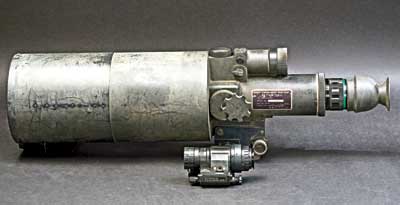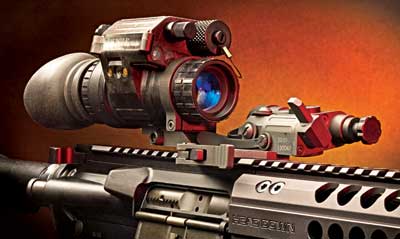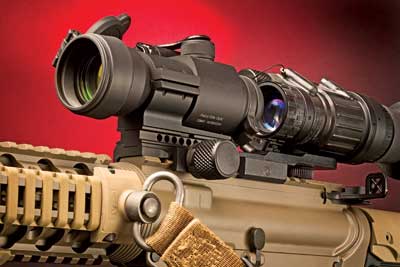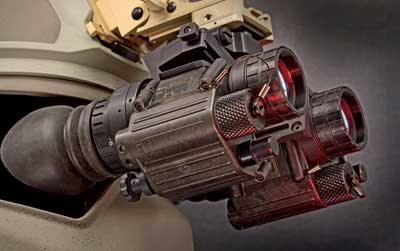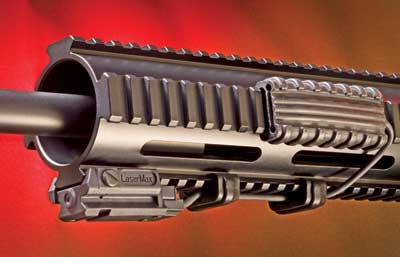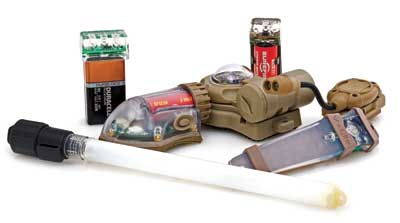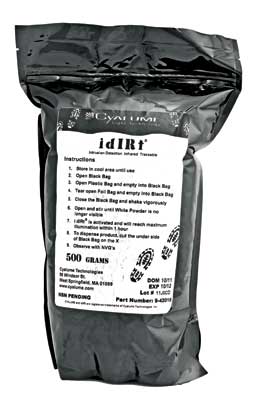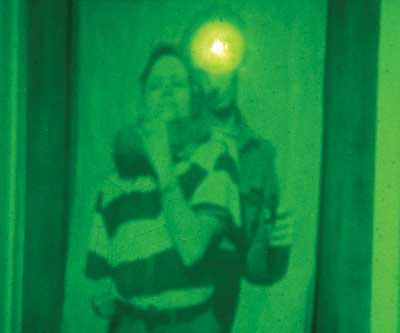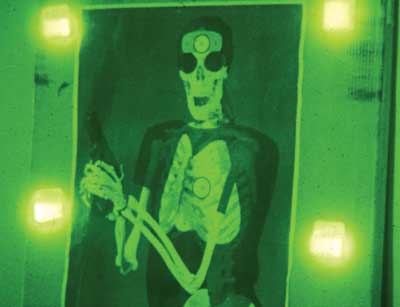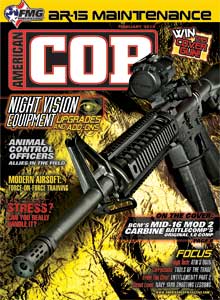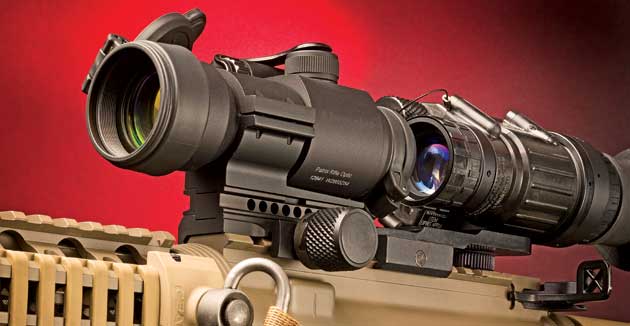
NV-2
Upgrades And Add-Ons.
The military is drawing down, government development contracts are being scaled back and the almost unlimited funding for R&D projects is drying up. Even though war in and of itself is abhorrent, it does bring about innovative thinking and the development of things useful in peacetime. World War II gave us the jet engine, the Civil War gave us submarines and Viet Nam gave us paramedics. Maybe the price paid was too high, but they’re here now, so let’s not let them go to waste.
Iraq and Afghanistan have provided leaps in night vision technology, as has every war since WWII. But, now much of those NV innovations are concentrated on enhancing existing devices, the most ubiquitous of which is the AN/PVS-14. It’s also the most law enforcement-friendly device for its relatively low cost, grant programs, diminutive size and its flexibility and adaptability.
It’s truly astounding how many products are now available to law enforcement, making night vision systems easier to use and more effective in a given task.
A real “then-and-now” reminder. That big, mega-pound night vision unit was all that was available just a few short years ago. Today, units the size of the smaller one deliver performance only dreamed of before, at lower cost and more efficient operating levels, offering rugged construction able to survive anything tossed at them.
Getting The Stuff
Most of the equipment in this article was secured through TNVC (Tactical Night Vision Company) and Morovision Night Vision. These folks know what’s up and what’s new in everything night vision (that includes thermal systems too). They are far and away the real subject matter experts who can make meaningful suggestions, and steer you to good decisions. They know what works and what doesn’t for a particular application and will be brutally honest with you.
Both companies have extensive websites for browsing to find what might interest you. But, the best thing about these companies is their customer support and guidance. Additionally, TNVC and Morovision are affiliated with world-class trainers who can fill your training needs and suggest equipment and accessories best suiting how you plan to use the equipment. Here’s just a taste of what they offer.
Armasight
The Armasight AIM Pro (Advanced Integrated Mount) is a night vision accessory allowing you to convert your night vision monocular into a weapon sight. The AIM Pro is incorporated into a low-profile housing with an integral Picatinny rail grabber mount on the underside and a dovetail mount on the top. The AIM Pro can be bore-sighted to your rifle by mounting AIM Pro on your rifle and fitting it with a NV monocular like the AN/PVS-14.
Conventional systems require the NV unit be mounted behind a day optic. The AIM Pro projects a reticule directly into the NV monocular lens. There’s no longer a reduced field of view through the NV device or any shadowed area. A HUD-type prism on the front of the AIM Pro unit projects a 65MOA circle and single 3.2MOA center-aiming dot directly into the monocular lens. It adapts to virtually any NV monocular. Another model, the AIM Pro-L, allows you to mount a 3X NV monocular directly on the weapon for extended range.
Aimpoint
The Aimpoint PRO is a perfect law enforcement option to marry with a night vision device. It was designed with input from a group of current and former LE and military professionals — not gun gamers — who actually use this equipment in real-life angry situations. It incorporates many features to maximize performance. A hard-anodized 30mm tube enclosing high-efficiency circuitry allows the sight to be turned on and left on for up to 3 years with a single battery.
The red dot can be turned down to night vision device-compatible levels, eliminating the halo effect from having it too bright. The front lens utilizes a unique band-pass coating, allowing the sight to be used with all types and generations of NV devices. The QRP2 mount includes a removable spacer indexing the sight at optimal height for co-witness with iron sights. The front and rear lenses are slightly recessed within the sight’s body, providing protection from impact damage, scratches and fingerprints. Also, the front lens bezel is threaded, allowing the use of an Anti-Reflection Device (ARD).
Dual Tube Bridge
Morovision is the distributor of this dual tube bridge, allowing the user to mount two AN/PVS-14s to their helmet. Why two, you might ask? A dual-tube binocular provides greater performance than a single-tube system by improving depth perception when operating vehicles or heavy equipment at night. Unlike the modern infantryman, most cops are not used to using a night vision device. It’s difficult walking at night on uneven ground, let alone driving or operating heavy equipment.
The Dual Tube Bridge can be handheld or attached to a standard PVS-7/14 head mount or helmet mount. Additionally, the PVS-14s can be easily detached from the dual-bridge assembly to create two separate NV monoculars that can be weapon-, camera- or video-adapted.
Zero Lens
The Zero Lens is manufactured by Torrey Pines Logic in the San Diego area and distributed by Black Optex. It’s an optical alignment adapter enabling use of NV monoculars in front of day sights to add nighttime engagement capability with no shift in the gun’s zero. It’s a non-electronic, compact device allowing enhanced capability to your existing optics at a fraction of the cost of adding new stand-alone systems.
Configuring the NV device in front of the day optic is more efficient and user-friendly than when the AN/PVS-14 is mounted behind the primary sight. Front mounting allows the shooter to maintain the same position, muscle memory and eye relief with his primary sight.
The Zero Lens’ standard quick-detach mounting system enables rapid installation and removal, allowing easy transition of the NV monocular between handheld, helmet-mounted or weapon-mounted use as your operation dictates. Once set, the Zero Lens will maintain alignment between the adjusted NV monocular and the day sight when re-installed.
I mounted the Zero Lens in front of Leupold’s new Mark 6 3-18X44mm tactical scope. I was amazed at the clarity of this combination, especially at 600 meters and beyond.
Tarsier Eclipse
A Tarsier is a primate with humongous eyes and really creepy little hands and fingers that lives on the Southeast Asian islands. It has some of the best natural night vision of any mammal. Look it up, you’ll see why. The Tarsier Eclipse is a product manufactured in Virginia Beach, Va. by MATBOCK. It fits on the front objective lens of an AN/PVS-14 and a bunch of other NV devices. It allows you to see objects from 18″ to infinity at the same time and without any loss of clarity.
The Tarsier Eclipse incorporates a smooth-action, high-performance optical iris, which can be quickly adjusted open or closed depending on the amount of ambient light. Additionally, it comes with a high-quality Corning Glass sacrificial lens replaceable in the field without tools. At complete open, it allows the NV device to act normally with no objective obstruction. At complete closed, it blocks all light from the objective except for a tiny pinhole. This allows the Tarsier Eclipse to be kept constantly mounted — doubling as a sacrificial window and objective lens cover. The replacement sacrificial window lenses are available separately.
Revision Batlshin Viper
Revision makes some of the finest protective eyewear available. They have a number of US military and NATO contracts, providing troops with eye-saving sunglasses, goggles and even laser protective glasses working in the invisible spectrum. As you can imagine, there’s a great need for them over in the sandbox.
A few years ago, Revision ventured into the world of protective headgear and came up with a unique, integrated and fully modular head protective system named the Batlskin Viper, and they didn’t just go halfway. The basic helmet is a lightweight, high-performance ACH helmet shell, but it integrates with a front mount accepting NV devices or their visor and a mandible guard. The Batlskin Viper was designed and field-tested to operate with various types of mission-dictated equipment, from night vision devices to communications gear and weapons sights.
The Viper’s polyethylene shell uses high-tech materials delivering protection from blunt force, blast, fragmentation and ballistic threats. It meets stringent quality standards and exceeds US Army specifications for blunt impact, blast fragmentation and ballistic threats.
If you’ve ever rolled around in the back of a SWAT vehicle when the driver hits the brakes, you’d really appreciate the mandible guard. It provides the same protection level as the helmet from fragmentation, ballistic and non-ballistic impact. It’s especially useful for a prison CERT (Correctional Emergency Response Team) during cell extractions. The face shield and mandible combination protects the officer from being splashed in the face with a prison “Milkshake.”
Lasermax
The LaserMax Uni-IR laser mounts on any Picatinny or Weaver rail and uses only 1.75″ of space, and it has a built-in rail on the bottom to mount other accessories. It’s the smallest and lightest weight IR laser on the market today. The body weighs about as much as a single .45 ACP round, so weight is a non-issue. The unit is also water resistant.
When mounted on a pistol, the slide-switch activation accommodates either right- or left-handed shooters. LaserMax’s Mantarail system and momentary activation switch attach to the Picatinny rail of an equipped rifle or long gun. Activation is accomplished by pressing the pressure switch. The Uni-IR takes two #357 silver oxide batteries and provides 6 hours of run time. They’re available at just about any drugstore; I found some at my local supermarket.
Ameriglo
AmeriGlo offers an impressive lineup of sights for just about any firearm you might own. But, what a lot of people don’t know is they also make and distribute chemical light sticks in both the visible and infrared spectrum. The infrared chem sticks are not visible to the unassisted eye — you need a night vision device to see the IR light produced. The process is called chemiluminescence.
The chem stick consists of two chemicals, a breakable glass vial and a dye in a clear plastic or colored tube. The chemicals inside the plastic tube are a mixture of the dye and diphenyl oxalate. The chemical in the glass vial is hydrogen peroxide. When the peroxide mixes with the phenyl oxalate, a chemical reaction takes place, yielding light. The color of the emitted light depends on the makeup of the dye. The reaction is slow and releases only light, not heat.
The AmeriGlo IR stick has special raised bumps on the stick’s housing. You can tactilely distinguish the IR stick from a visible spectrum colored light stick prior to activation. This unique feature prevents accidental activation of a visible spectrum stick, giving away your position or intended actions.
Another IR product from AmeriGlo is their Safety Square. It’s a 3″ square plastic container with an adhesive backing. The Safety Square is activated the same as a chem stick and provides plenty of IR light. You can use it in training rooms, marking ingress or egress routes and indicating cleared rooms.
Brite-Strike Apals
All Purpose Adhesive Light Strips, APALS, were designed for military operators searching for a low-cost, ultra reliable, long-lasting combat identifier. The law enforcement crossover is obvious. They enhance situational awareness, giving you the ability to safely monitor the movement of team members in low/no-light environments and to reduce possible blue-on-blue engagements.
They’re great when used to mark areas already searched when looking for a suspect in an office building or home. Just slap the adhesive side on the door and continue your search. The hermetically sealed APALS are intended for use in the worst possible conditions, from searing heat to frigid waters or the wet and freezing wooded areas known to many rural jurisdictions. APALS from Brite-Strike are disposable, but have a runtime of more than 35 hours.
More Cool Things
Both Morovision and TNVC offer full catalogs of cool IR marking devices. Some can be used to mark trails, just like IR breadcrumbs, or in an Identify Friend or Foe (IFF) role. Wearable IFF beacons that strobe or remain in constant-on mode are practically a must when conducting night ops with NV devices. They don’t even need to be on the outside of clothing. Drop it in the users pocket and it’s just as bright to the NV device.
Cejay Engineering, for example, has a number of IR strobes available through TNVC and Morovision. One strobe is as small as a 9-volt battery. You can put it in a taillight assembly or under a targeted suspect’s car for surveillance operations either on the ground or airborne.
Idirt
One of the cooler items I came across is idIRt. No, my caps lock key didn’t go crazy, that’s the way they spell it. It comes from Cyalume Technologies Inc. via TNVC. It’s a new light product that looks like dirt, but it glows when properly mixed and observed with a NV device. The name stands for Intrusion Detection Infrared Traceable. It’s intended to be sprinkled on the ground. You can use it across a path or trail and if it’s disturbed, you know someone’s been through there. idIRt will remain on shoes or tires to serve as a marker you can use to identify a suspect. It’s available in ready-to-mix packages. You combine the two proprietary components and it will provide IR illumination for 36 to 48 hours outdoors and up to a week indoors.
LaserMax Uni-IR at 10M using an AN/PVS-14 makes fast precision shots possible.
A weapon-mounted dedicated IR light can be become very
useful when engaging targets or searching at distance.
AmeriGlo’s IR Safety Squares are very bright, compact and produce light for about 3 hours.
A Quick Reminder
A number of manufacturers offer dedicated IR weapon-mounted flashlights, dramatically increasing the range of view with a weapon-mounted NV device. There are IR filters available too, however don’t try using them with white LED lights; they won’t work. You’ll need a non-LED bulb for the filter to function — or just get a dedicated IR LED light.
By Dave Douglas
For more info: www.americancop.com/index and click on the company name.
Order Your Printed Copy Of The American COP February 2014 Issue Today!
Download A PDF Of The American COP February 2014 Issue Now!

